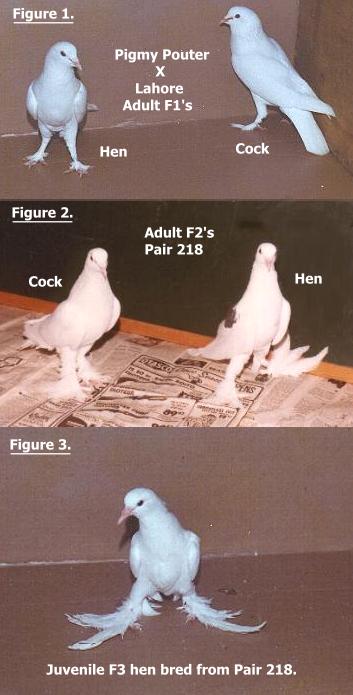Mangile's Pigeon Pages
Pigeon Science & Genetics Newsletter
Issue #1
January? 1976, pages 16-18.
Synthetic Muffs In Pigeons
By Robert J. Mangile
816 E. Atkinson Ave.
Pittsburg, Kansas 66762
It appears, from reviewing literature (Levi 1957, 1965), that
breeds of pigeons with feathered feet were well established in India
and elsewhere over 400 years ago. Presently, there are many
established
feather-footed breeds throughout the World and attempting to categorize
examples leads one to conclude that breed differences are primarily the
length of foot feathers and which toes are involved.
[Photos by Kerry Hendricks,
1974-75. These photos not used in the original article but are of
the same birds.]

A review by Dr. W. F. Hollander in 1965 on Foot Feathering deals
with
three foot feathering types, i.e., muff, grouse and slipper; and
speculate that muff is a combination of slipper and grouse. This
idea
interested me and I decided to test it.
I paired a well slippered, white Pigmy Pouter cock to a well groused,
typically marked milky ash-red Lahore hen. They produced six (6)
solid
white
F1’s (3 cocks and 3 hens) with foot feathering similar to grouse, but
with middle toes having longer feathers, very similar to offspring from
a muffed X clean-legged mating (Fig. 1).
The three pairs of F1’s produced thirty-one (31) F2’s with foot
feathering ranging
from clean-legged, with only a few tiny feathers present, to a clearly
defined muff condition.
Overlapping phenotypes distorted F2 classification; however, four
(4) were
typical slippered, four (4) less than slippered with few feathers on
legs and
toes, one (1) specimen recorded as totally clean-legged and twenty-two
(22) ranged from
grouse to muff with a variety of conditions, of which one was neatly
groused and at least one was muffed. Broken feathers complicated
classification of small-muffed and muffed conditions, but one F2 hen
(Fig. 2) retained a muffed condition into adulthood; therefore, showing
that muffs were synthesized from lesser foot-feathered conditions;
i.e., slipper and grouse.
The two best-muffed examples of the thirty-one (31) F1’s were cock and
hen and were
mated together (Fig. 2). Of fifteen (15) offspring (F3’s)
produced, foot
feathering was mostly (Fig 3) muffed with twelve (12) having small to
large
muffs and three (3) being heavily slippered. No groused or
clean-legged
examples were produced.
Discussion
Though there is some confusion as to
dominance or recessiveness of foot feathering, Hollander's suggestion
of the symbol “gr” for grouse, and slipper as a separate unit will be
followed in this report. The symbol “s1“ will be used for slipper
although it has not been well analyzed.
Speculating that both are independent traits, we may assume all F1’s
are heterozygous; i.e. sl//+ +//gr genotypes. Test results
indicate
that a muffed condition can be produced from slipper-grouse
heterozygotes. However, it remains questionable whether muffs can
be
extracted from slipper or grouse conditions alone, by selection.
All
F1’s display a condition intermediate between parents and the F2’s
include two conditions not possessed by either parent; i.e., clean-leg
and muff conditions, strongly suggesting a dihybrid cross.
Apparently, the basis of muff is the interaction of homozygous slipper
and homozygous grouse. Presence of other modifying genes seems
likely
when considering such breeds as English Trumpeters and Swallows, which
are very heavily muffed with large feathers extending to their upper
legs. None of the muffed examples of the F2’s or F3’s reached
such a
condition.
Considering the selection of F2’s, it is significant that twelve (12)
of fifteen (15) F3’s
were classified as muffed, indicating homozygosity. Muffed
examples
displayed varying degrees of toe webbing involving middle and outer
toes, in both F2’s and F3’s; none of which had toes joined their entire
length.
All offspring were bred in individual breeding coops, excepting the
last two F3’s.
Longest foot-feathers measured 4 inches in well-muffed examples.
Literature Cited:
- Hollander, W. F. 1965. "On the origins of domestic genes, XIV.
Foot
Feathering." National Pigeon Association News, June p. 8-9.
(Reprinted in Pigeon Genetics News Letter #47 p. 18-19)
- Levi, W. M. 1957 revised edition of The Pigeon. Levi Publishing
Company, Sumter, South Carolina.
- Levi, W. M. 1965. Encyclopedia of Pigeon Breeds. Levi
Publishing
Company, Sumter, South Carolina.
# #
#

